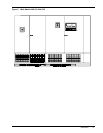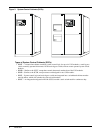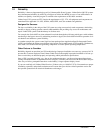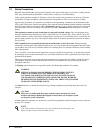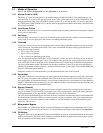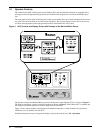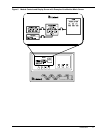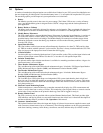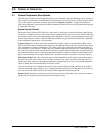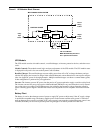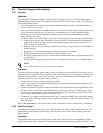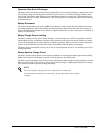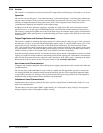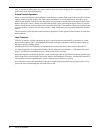
Theory of Operation 13
2.0 THEORY OF OPERATION
2.1 General Component Descriptions
The UPS system includes all of the equipment necessary to continuously provide computer-grade AC power to a
critical load, even when there is an interruption of the utility line power. It consists of a System Control Cabinet
(SCC), UPS modules, and a back-up battery plant. Refer to Figure 6 and Figure 7. Except where otherwise
noted, the configuration is presumed to be parallel-redundant (with at least one more UPS module than required
to support the rated load).
System Control Cabinet
The System Control Cabinet (SCC) includes system controls, static bypass switch, load transfer control, protec-
tive devices, and other accessories. The system controls simultaneously monitor two or more parallel UPS mod-
ules sharing a critical load for increased capacity and/or redundancy. The two (2) motor-operated system circuit
breakers (system bypass breaker—SBB and UPS output breaker) may be contained within the SCC, depending
on the configuration designed for your installation.
System Controls: The system control logic automatically manages critical bus operation and monitors perfor-
mance of the UPS modules. Microprocessor technology and dedicated firmware provide advanced logic control
and a comprehensive display of information. The system control logic synchronizes the output of the UPS sys-
tem to the bypass source. The SCC includes ports for communicating with external devices. Liebert Multi-Mod-
ule Units do not require an SCC for load sharing. Automatic, parallel module load sharing is a function built into
the modules themselves; however interconnection through the SCC enables the modules to share data for more
precise control. Modules do not require master clocks or controls in order to load share or free-run at 60.0 Hz.
Static Bypass Switch: The static (solid-state) bypass switch immediately transfers the load from the inverter to
the bypass AC power source in the event of a severe overload on the system or a failure within the UPS. This
transfer takes place without any interruption of the power supplied to the load. The system includes redundant
circuits to detect and isolate shorted SCRs in the static switch.
Fuses are installed in series with the static bypass circuit to ensure reliable overload protection in the unlikely
event of a catastrophic output condition (e.g., a dropped wrench) electrically close to the output of your UPS sys-
tem. The static switch SCRs themselves are rated to easily handle the fuse-blowing current.
Bypass Circuit: The bypass circuit consists of electrically operated circuit breakers and associated synchroniz-
ing and control circuitry to transfer the load to/from the bypass source.



